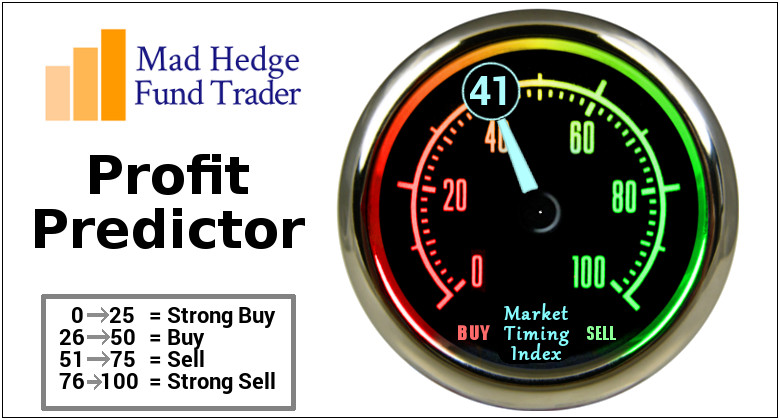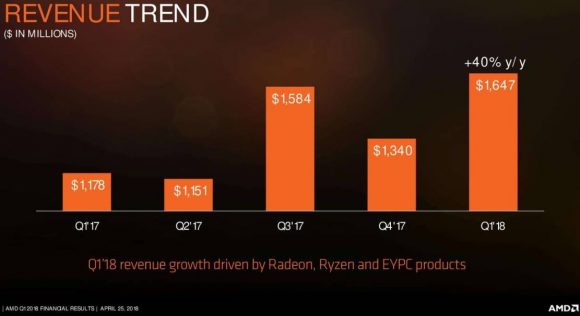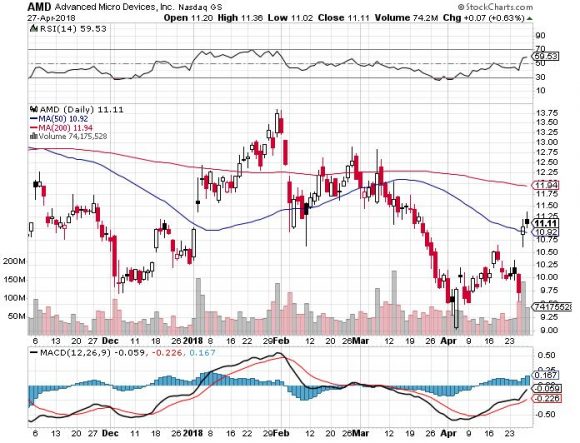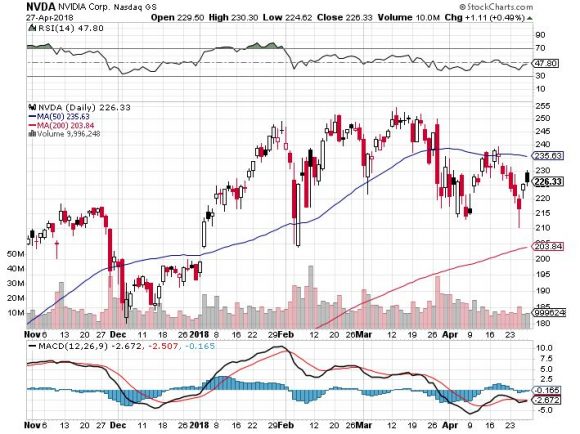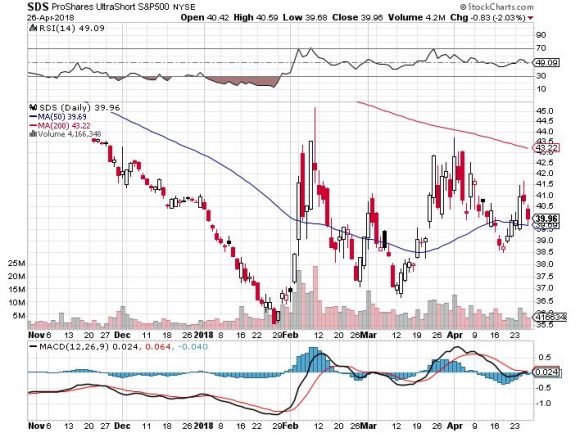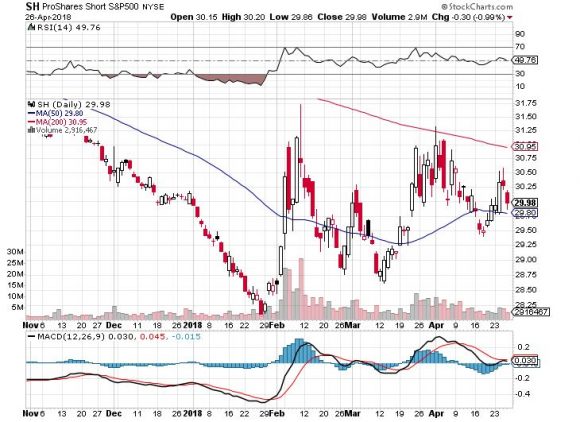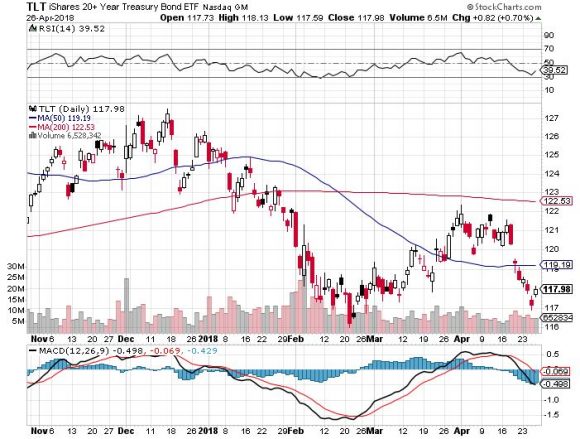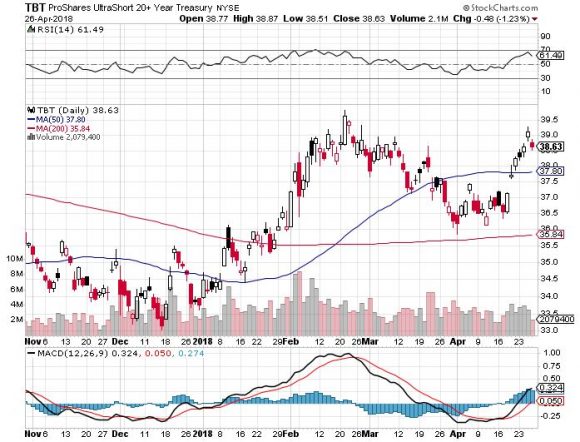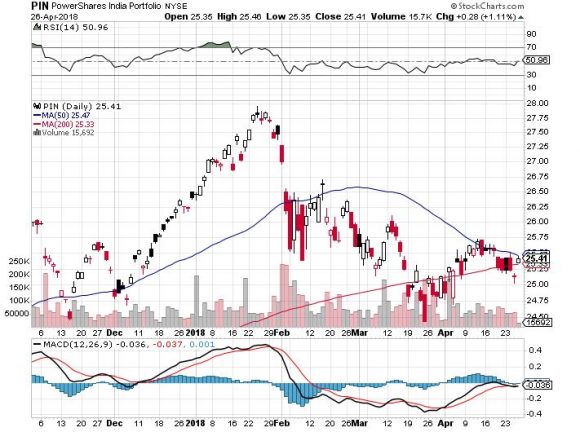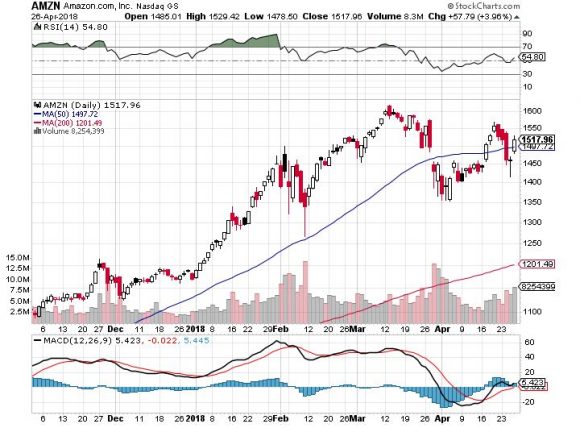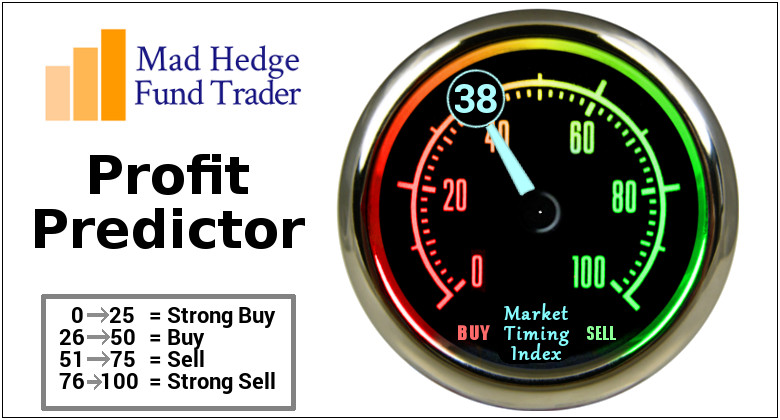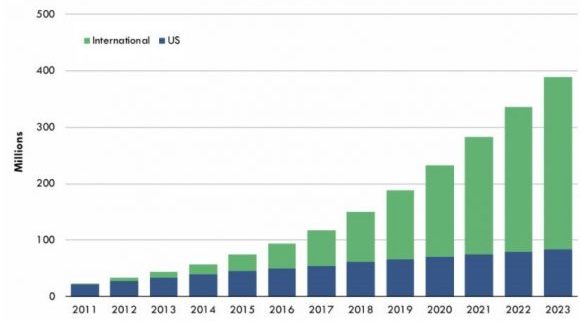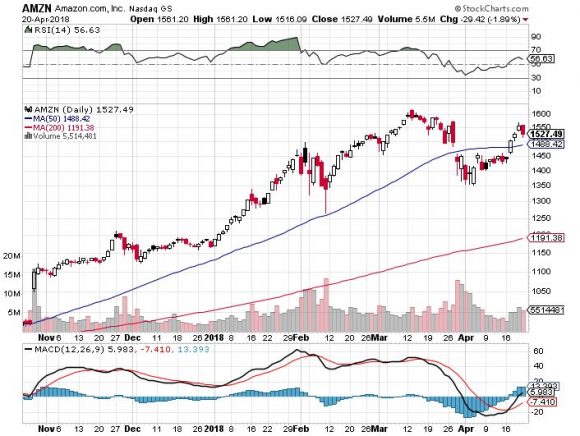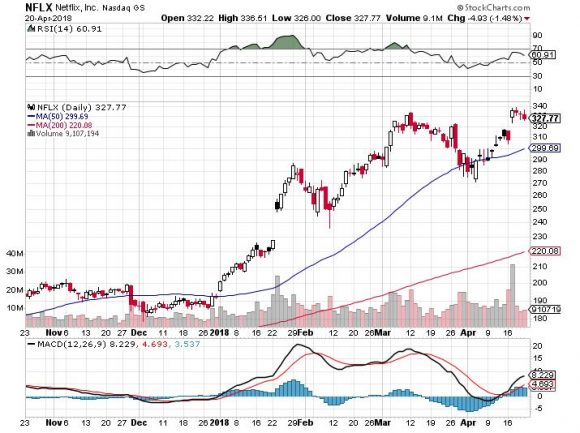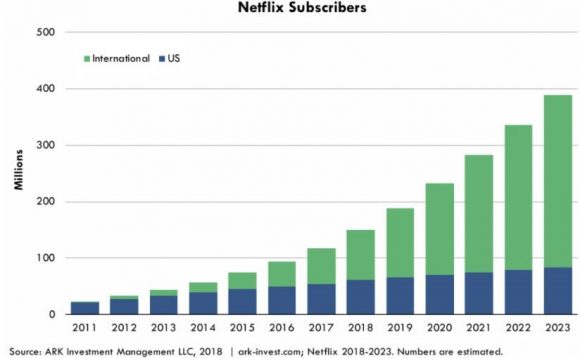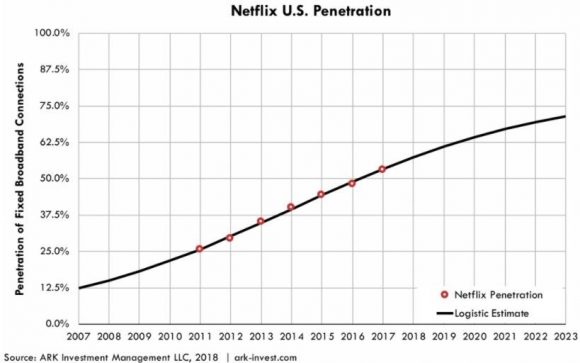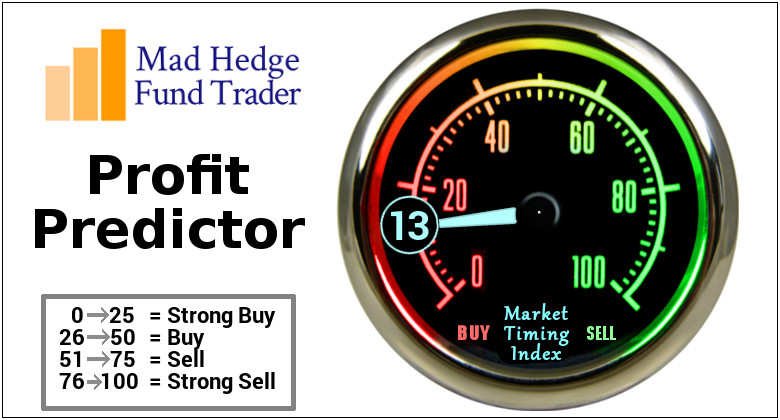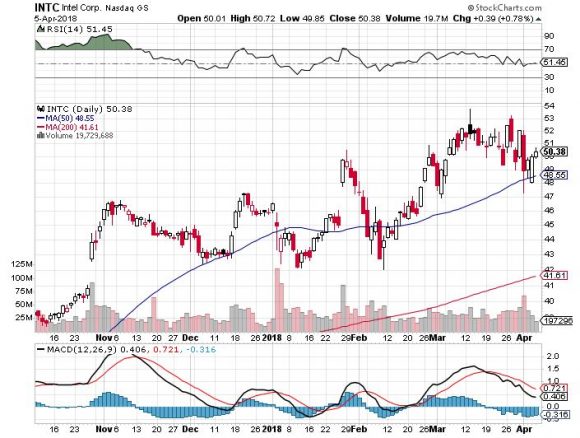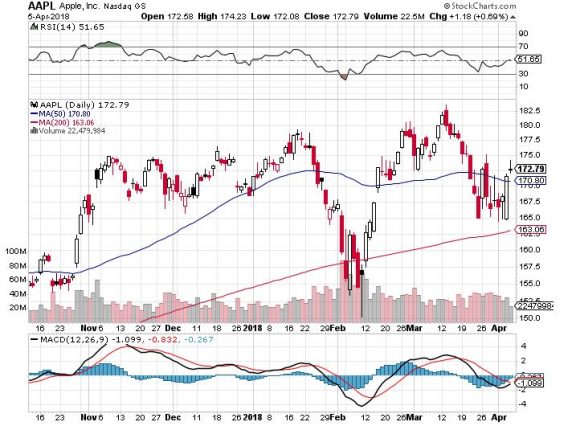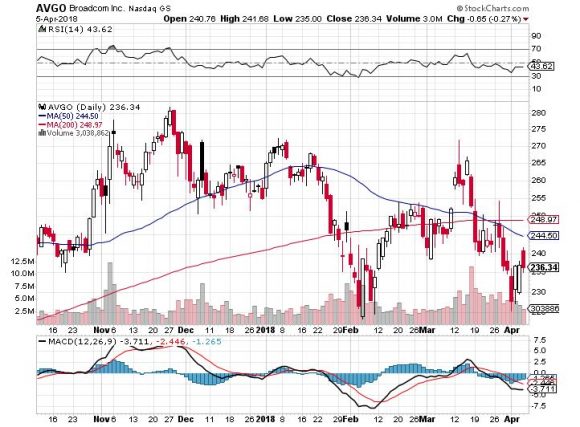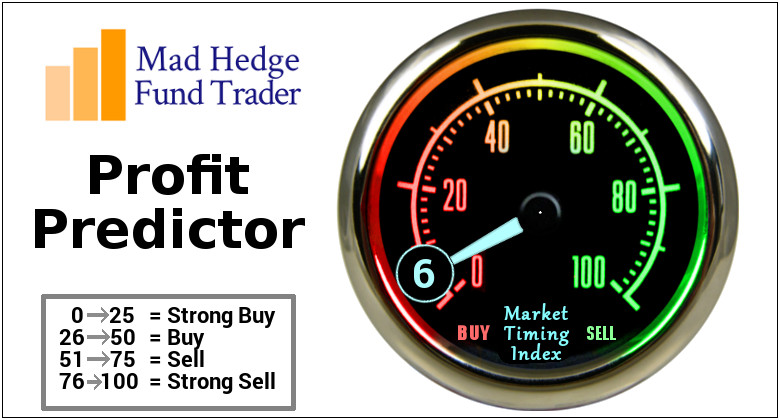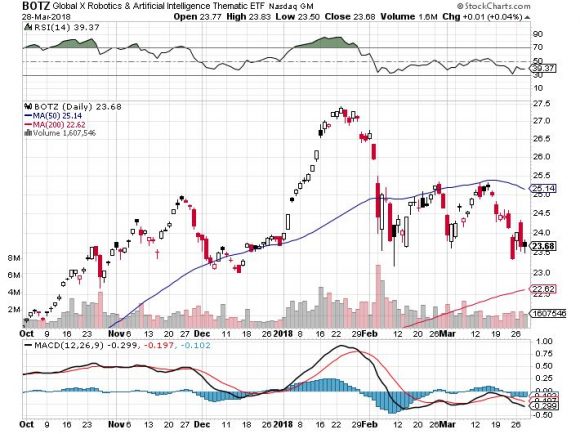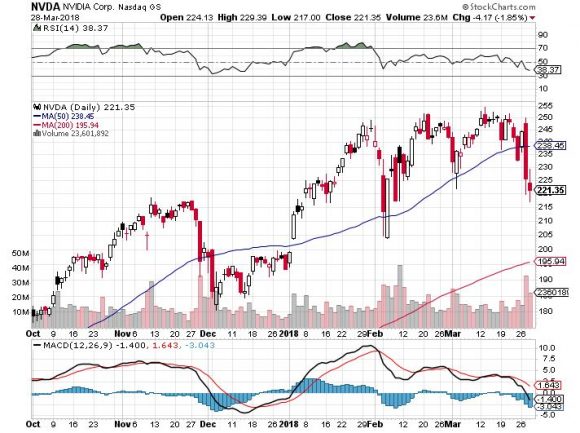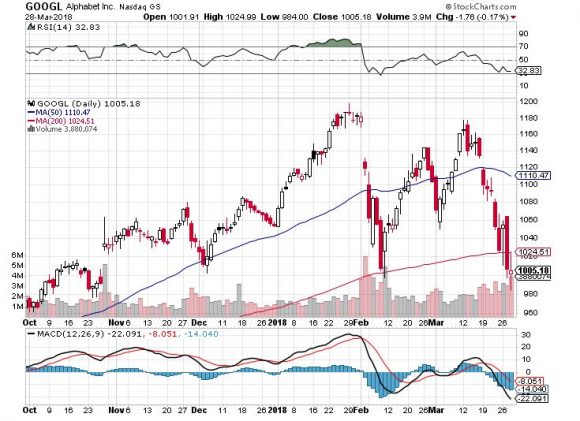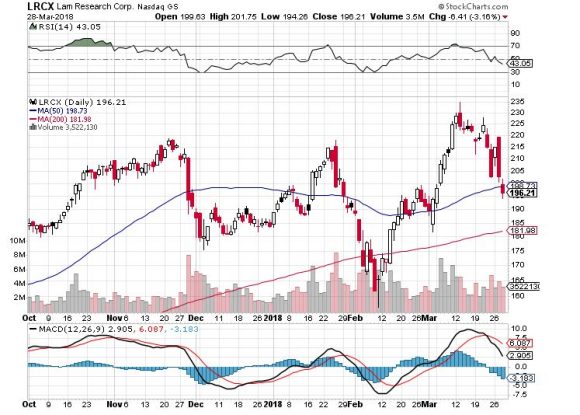Mad Hedge Technology Letter
April 30, 2018
Fiat Lux
Featured Trade:
(RIDING THE CHIP ROLLER COASTER),
(Samsung), (SK Hynix), (AMD), (NVDA), (INTC), (MU)
Posts
The supply side of the chip market is spectacularly volatile, rotating between supply constraints and times of overcapacity.
A good place to analyze the heartbeat of the chip market is across the Pacific on South Korean shores.
South Korea takes pride and joy in having given the world two first-rate semiconductor companies - Samsung and SK Hynix.
Samsung is just behind Intel (INTC) in total annual sales.
American consumers are more familiar with Samsung through its consumer electronics division that constructs Samsung smartphones and tablets.
Samsung's silicon business mirrors the elevated earnings results stateside, as muscular demand derived from global data center expansion devours more chips than Samsung can pump out.
Global data centers in the U.S. and Asia will sustain blistering growth levels into the second quarter.
Samsung has displayed resilience to seasonally shift in the consumer electronics segment by staunchly bolstering its relentless chip business.
Samsung is harvesting the benefits of bountiful investments from over the past decade when this overly cyclical industry was exposed to extreme shifts in worldwide appetite for consumer electronics devices.
More than 70 percent of revenue was generated by the chip division boasting quarterly revenue of $19.25 billion.
In the past, memory chip companies endured a ruthless market environment with a diverse set of players ratcheting up supply on a whim then finding demand crumbling before their eyes.
Restructuring has left the burden of supplying the next generation of technology a backbreaking burden.
Tight chip supply and the general shortage of hardware rears its ugly head in earnings reports with a slew of CEOs complaining about input prices rising worse than global warming sea levels.
In Samsung's earnings call, management groaned that "memory supply and demand fundamentals remain tight."
In SK Hynix's earnings call, it echoed that "demand and supply dynamics in the market will remain favorable."
As large cap tech expands data center initiatives and throws piles of money at autonomous cars, A.I. and cloud computing, Samsung's semiconductor division appears nearly immortal.
Chip prices skyrocketed in this sellers' market and the UBS downgrade of Micron (MU) was a headscratcher.
Analyst Timothy Arcuri turned bearish on Micron citing "cyclical memory concerns" and "big estimate cuts."
Sometimes it feels that analysts don't follow the industry they cover.
It is fair to say chip volume might face marginal cuts closer to 2019, but the pendulum hasn't even started to shift back over to that direction.
Suppliers and buyers both agree that capturing the appropriate volume of chips is the first order of the day.
In response to outsized demand, Samsung will double chip capital spending because of failing to match skyrocketing demand.
Fortifying the bull case, SK Hynix guesstimated DRAM demand for the rest of 2018 to be in the "low-20 percent" and even the injection of new funds for facility expansion is not a proper solution.
Samsung also hammered into investors that it is not in the business to drive the chip prices to zero, and the gross profit metric is more important to them than most people expect.
A goldilocks scenario could ensue with Samsung supplying enough to create price hikes and ploughing its cash back into more silicon expansion.
Korean memory chip producers are expected to enjoy a booming business during the remainder of this year as global DRAM chip demand will surpass supply.
SK Hynix also indicated that server products would supersede mobile products as data center related products are all the rage.
Korea's No. 2 said NAND demand would rise by "mid-40 percent" in 2018, which is double the rise in demand than DRAM products.
Instead of the estimate cuts on which UBS is waiting, the more likely scenario is an easing of chip constraints. The easing will last just long enough before the next massive wave of demand hits with a vengeance.
You read my thoughts - the generational paradigm shift due to hyper-accelerating technology has largely made the boom-bust cycle irrelevant.
Chip demand will go up in a straight line, and this is just the beginning.
Legend has it that demand weakness shows up every 15 years. The last one was the global financial crisis in 2008, and the one before that was the dot-com crash of 2001.
In both instances, the disappearance of demand contributed to massive oversupply. The declining prices set off a price war eradicating margins and revenue.
SK Hynix net profit was $2.89 billion last quarter, an increase of 64.4 percent YOY.
SK Hynix capital allocation layout includes a spanking new factory in Cheongju, a city in South Korea.
The insatiable demand brought on by China's quest for technological supremacy is the market the new Cheongju factory will serve.
International chip directors fret that a sudden breakthrough in local Chinese technology could ignite a supply bonanza of cut-rate semiconductors, forcing a recapitulation of the entire industry that encountered egregious oversupply issues about 10 years ago.
But China can't dump low-cost chips into the market due to technological frailties.
Notice that Chinese capital has been flirting with American chip companies for years without success.
The Chinese government even initiated an investigation at the tail end of last year because DRAM price spikes were indigestible for local Chinese companies.
The dearth of supply is not just restricted to one extraneous niche of the hardware industry, as the tightness is broad-based.
Don't look further than AMD (AMD), which specializes in GPU (graphics processing unit) products and has received glowing reviews for its Ryzen and EPYC CPU processors that boast higher-level performance than previous products.
The RX Vega series is the new line of GPUs from AMD that launched last August. Tech-enthusiast website techspot.com described finding these GPUs on sale in stores as "next to impossible."
AMD is well informed of the market outlook and NVIDIA (NVDA) notes that hardware-intensive cryptocurrency mining is stoking excess marginal demand for its products.
AMD is boosting production, but manufacturing is set back by a component shortage in GDDR5 memory, which is needed in the RX 400 card.
The RX 500 card, part of the RX Vega line, is also having delays with a lack of HBM2 memory.
Crypto-fanatics aren't the only consumers clamoring for extra GPUs; gamers require GPUs to perform at top levels.
AMD has even urged retailers to advise gamers of any outlets where they can buy GPUs because of the dearth of supply.
Gamers are being outmaneuvered for GPUs as crypto-miners usually buy up every last unit to transport to mining farms in far-flung places with cheap energy.
Hardware products cannot be produced fast enough to meet demand.
Other industries vying for a portion of chips are military, aerospace, IoT (Internet of Things) products, and autonomous cars.
Incremental supply is accruing but often the supply is added slower than initially thought. Suppliers are hesitant to double down on new factories because of past, bitter experiences at the end of a cycle.
Management monitors inventory channels like a hawk eyeing its prey, and it's clear that organic demand is following through.
After running away with 22.2% growth in 2017, the semiconductor industry is due to take a quick breather expanding in the upper teens in 2018.
A year is an eternity in technology and calling for production "cuts" in a period of massive undersupply is premature.
The claim of "cyclical" headwinds comes at a time of a new-found immunity to cyclical demand and is dubious at best.
This secular story has legs. Don't believe every analyst that pushes out reports. They often have alternative motives.
Nvidia (NVDA) reports earnings on May 10, and CEO Jensen Huang does a great job explaining the development at the front-end of the tech revolution.
Earnings should be extraordinary. Imagine if the price of bitcoin stabilizes, GPU manufacturers will wrestle with continuous quarters of strained supply.
I am bullish on chips.
_________________________________________________________________________________________________
Quote of the Day
"Focus on the 20 percent that makes 80 percent of the difference." - said Salesforce CEO Marc Benioff when asked to explain the story of his cloud business.
April 27, 2018
Fiat Lux
Featured Trade:
(THURSDAY, JUNE 14, 2018, NEW YORK, NY, GLOBAL STRATEGY LUNCHEON)
(APRIL 25 BIWEEKLY STRATEGY WEBINAR Q&A),
(TLT), (TBT), (GOOGL), (NVDA), (PIN),
(SPY), (C), (AMD), (EEM), (HEDJ)
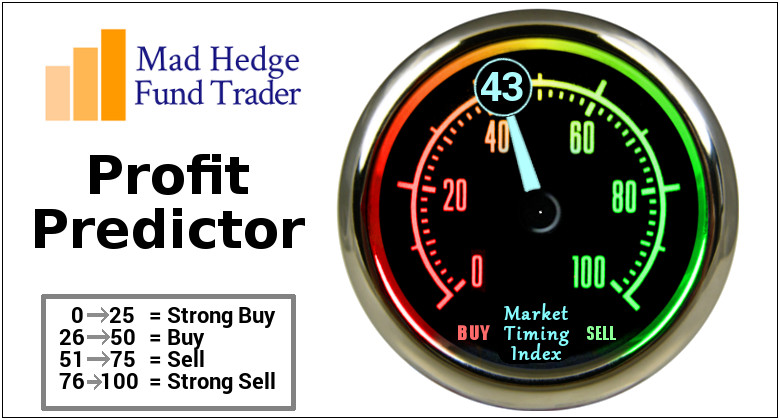
Below please find subscribers Q&A for the Mad Hedge Fund Trader April Global Strategy Webinar with my guest co-host Mike Pisani of Smart Option Trading.
As usual, every asset class long and short was covered. You are certainly an inquisitive lot, and keep those questions coming!
Q: Are you out of Alphabet (GOOGL) and Microsoft (MSFT)?
A. I'm out of Alphabet and I'm in Microsoft, but only for the very short term. I'm waiting for another big meltdown day to go back and buy everything back because I think the FANGs and technology in general are still in a secular bull market.
Q. Are Advanced Micro Devices (AMD) and NVIDIA (NVDA) affected by the underperformance of Bitcoin?
A. They are. Bitcoin has been an important part of the chip story for the last two years because mining, or the creation of bitcoins, creates enormous demand for chips to do the processing. I think selling in bitcoin is over for the time being. You had a $25 billion in capital gains taxes that had to be paid by April 15.
People were paying those bills by selling their bitcoins. That's over now, and bitcoin is rallied about 30% since Tax Day because of that. So, yes, bitcoin is getting so big that it is starting to affect the chip sector meaningfully. That is another reason why we see secular long-term growth in the entire chip sector.
Mike Pisani: Interesting take on bitcoin today, and I've been with you on it. I think the worst of it is over; it's going to go. Today is the largest volume day we've seen on it so far. We're up over 15,500 contracts traded.
Q: If you're 100% cash, is now a good time to commit funds to the equity market?
A. Franz, I would say nein. Absolutely not. 2009 was the time to commit funds to the equity market. If you're 100% cash now I would stay out for the next six months. We may get a good entry point over the summer or the fall. I'll let you know when that happens because I will be jumping back in myself.
But right now, a week ahead of the worst six months of equity investment of the year, I would stay away and do research instead. Read your Mad Hedge Fund Trader letters. Build a list of names that you're going to buy on the next meltdown and practice buying meltdowns with your practice account, which doesn't use real money.
There's a lot of things you can get ready to do for the next leg up in the bull market, but buying right now, NO! I would put that in the category of, "Is it time to start shorting bonds question?" that we got a few minutes ago.
Q: Why did tech stocks sell off when they have great earnings results?
A: It's called, "Buy the rumor, sell the news." So many people already own the stocks and were expecting good earnings that there was no surprise when they were announced. These are some of the most over-owned stocks in history.
Everybody in the world owns them. Many people have multiple weightings in them, so when we enter a high-risk macro environment, which we have now, you want to get rid of the most over-owned stocks. That is exactly why all of these stocks that have had great runs are selling off, even though they have great earnings report.
Q: Are financials a good play here with interest rates rising though 3%?
A. Normally I would say yes. However, the macro background for the general market are so negative they are overwhelming any positive fundamentals specific to individual sectors like banks and stocks like Citigroup (C). By the way, financials all reported great results and got killed, so that is why I bailed out of my (C) position this morning at around cost. If you throw the best news in the world on a stock and it won't go up, it's time to get out of there.
Q: Would an unleveraged inverse ETF like the ProShares Short S&P 500 ETF (SH) be good at a spike even now?
A. Yes, but when I say spike up better expect at least 20 (SPY) points or 1,000 Dow points. All these downside ETFs are great but you've got to get in at the right price. You know as they say in trading school, the profit is always made on the "BUY" and not on the "SELL."
So, if you can get on one of these super spikes up on the short side that is a great trade. So is the ProShares Ultra Short ETF (SDS) if you want to do the 2X leverage short fund. We've recently started doing this every month. We've been shorting (SPY)s and buying (VIX) on every one of these spikes up, and it's been working like a charm.
Q: Here's the best question of the day. Your timing has been perfect says Mary in Chicago, Ill.
A: Well, I'll take that kind of question all day long. Thank you very much. You're too nice to do that.
Q: Richard is asking would you buy an NVIDIA (NVDA) LEAP?
A: I would wait for meltdown days. Remember this is a market that gives you lots of meltdown days. Just wait for the next presidential tweet and you might get another 600-700-point dip in the markets. Those are the days you buy LEAPS. You don't have to get buy writing Trade Alerts like I do. You can just enter a limit order in your account. Put it as a stupidly low level to "BUY" and you may get hit. And that's where you really make the big money in this kind of market.
Q: Is there a good one- or two-month trade in Amazon?
A: Yeah, Paul, with this volatility you can pick a big winner like Amazon and you know to buy the 250-point dips and sell the rallies. These ranges are so wide now that even a beginner can make money. So, I would say you have to wait until after tomorrow on Amazon and let them get their earnings out. We know they're going to be great. They're doing home deliveries now to your car.
Q: Can long bond interest rates go up to 4%, and if that happens what would the market do?
A: Yes, they can go up to 4%, and I expect them to probably do that next year. What will it do to the market? Answer: Cause a bear market and a recession. Is that answer clear enough? My bet is that interest rates cap in this cycle much lower than they did in past cycles, maybe 4%-5%. We have been used to zero cost of money for so long that a move to 4% would be like stabbing somebody in the chest. People are much less able to deal with rising rates than they ever have been in the past, so watch this space.
Q: Should I buy the ProShares Ultra Short Treasury ETF (TBT) or the iShares 20+ Year Treasury Bond Fund (TLT)?
A: Brad, it's really is a leverage question for you. The (TLT) is 1X; the TBT is 2X, so I would be taking profits on the (TBT) here and then buying a couple of points lower. Or if you want to keep it for the long term you can but remember the cost of carry on the TBT is around 7% a year.
Q: Yves in Paris, France is asking: What possible scenario will you see material wage growth that could lead to higher inflation?
A: We're starting to see that now with the ultra-low unemployment rates. People are having great difficulty hiring anyone in technology. But at the minimum wage level there seems to be plenty of supply. The other possibility is that the cost of everything else goes up but wages, because technology is replacing jobs so fast there may never be any increase in wages.
So, we will get inflation, but nothing like the inflation we saw in the past driven by rising wages, commodity prices, oil prices, and interest rates. Yes, money is a commodity, which can add quite a lot to the cost of leveraged companies like airlines, REITs, and so on.
Q: Will rising interest rates force the US dollar up?
A. The answer is yes! It has been a long time coming, but if rates continue to rise from here, you can expect that to lead to a continuously rising dollar and falling foreign currencies, and that will become a major drag on the economy and corporate earnings going forward.
Q: When is a good time to buy TIPS?
A: Just like your Treasury bond short, I would buy Treasury Inflation Protected Securities (TIPS) on the next rally in bond prices (TLT) and dip in yields. That will give you a decent entry point. That said, TIPS have been a horrible performer for the last 10 years because there has just been no inflation. A lot of people just keep TIPS as a hedge in their portfolio and it just costs them money every year.
Q: Which could blow up, Brad wants to know, TBT or TLT?
A: The easy answer there is probably neither. But if I had to pick between the two, the (TBT) would be the one to blow up because it's a 2X and has a lot less liquidity. So, I can't image in what world has (TBT) blowing up, but then I don't watch zombie TV shows either.
Q: I think US equities are expensive. Are emerging markets (EEM) or Europe (HEDJ) a better bet for the rest of the year?
A: I would say yes. Because if interest rates here in the US go higher that means a stronger dollar. That means a weaker US stock market. Because US companies are punished by a rising dollar. And European and Asian companies benefit from a rising dollar and falling home currencies, so that makes Europe the first choice of any of the global markets.
Q: Does oil going to $100 have a chance of bringing down the US economy?
A: Absolutely yes. If oil prices don't start to slow down, they will start having a big impact on the economy because that means rising prices for any energy consumer, which is you and me.
With no ability to offset that by rising prices of your products that would put a squeeze on any oil consuming industry, which is why things like the transports and consumer staples have been performing so poorly. If we get to $100, then you're really looking at a full-on recession and bear market for stocks. By bear market I mean down 25% or more in stocks.
Q: How do you see the India ETF?
A: We like it. India is the No. 1 pick of any hedge fund investor in emerging markets, and the ETF you can buy there is the PowerShares India Portfolio ETF (PIN).
Mad Hedge Technology Letter
April 23, 2018
Fiat Lux
Featured Trade:
(HOW NETFLIX CAN DOUBLE AGAIN),
(NFLX), (AMZN), (IQ), (ORCL), (MU), (AMAT), (CRUS), (QRVO), (IFNNY), (NVDA), (JD), (BABA), (MSFT)
The first batch of earnings numbers are trickling in, and on the whole, so far so good.
A spectacular earnings season will further cement tech's position at the vanguard of the greatest bull market in history.
The bull case for technology revolves around two figures indicating "RISK ON" or "RISK OFF".
The first set of numbers from Netflix (NFLX) emanated sheer perfection.
Netflix has gambled on its international audience to drive its growth and unceasing creation of premium content to reach these lofty targets set forth.
It worked.
Consensus was that domestic subscription growth had peaked, and Netflix would have to lean on overseas expansion to beat earnings estimates.
American subscription growth knocked it out of the ballpark, beating expectations by 480,000 subscriptions. The street expected only 1.48 million new adds. The 1.96 million shows the American online streamer is resilient, and the migration toward cord-cutting is happening faster than initially thought.
International adds were pristine, beating the 5.02 million estimates by 440,000 million new subscribers.
Content is king as Netflix has proved time and time again (we notice that here at Mad Hedge Fund Trader, too). Netflix plans to fork out about 700 original series in 2018.
By 2023, Netflix could grow its subscriber base to close to 400 million. The potential for international advancement is immense considering foreign companies are playing catch-up and cannot compete with the level of Netflix's content.
The earnings report coincided with Netflix announcing a forceful push into Europe, doubling its allocated content-related investments to $1 billion.
All of Netflix's estimates take into consideration that it is shut out of the Chinese market. Ironically, the Netflix of China, named iQIYI (IQ), just recently went public on the Nasdaq.
Amazon Web Services (AWS), the cloud-arm of Amazon (AMZN), revenue numbers are the other numbers that are near and dear to the pulsating heartbeat of the bull market.
Jeff Bezos, Amazon's CEO, penned a letter to shareholders that Amazon prime subscribers blew past the 100 million mark.
The positive foreshadowing augurs nicely for Amazon to surprise to the upside when it reports earnings next week on April 26.
Expect more of the same from cloud companies that are overperforming.
The few glitches in tech are minor. It is mindful to stay on the right side of the tracks and not venture into marginal names that haven't proved themselves.
For instance, Oracle (ORCL) had a good, not great, earnings report but shares still cratered after CEO Safra Catz dissatisfied analysts with weak cloud forecasts of just 19%-23% growth.
The street was looking for cloud guidance over 24%. Oracle is still being punished for its legacy tech segments.
The chip sector got pummeled after several chip manufacturers announced weak supply order from Apple.
This is hardly a surprise with Apple slightly missing iPhone estimates last quarter by 1%.
Chip stocks such as Lam Research (LRCX), Micron (MU), and Applied Materials (AMAT) look like affordable bargains. They should be seriously considered after share prices stabilize buttressed by support levels.
The outsized problem is that hardware suppliers have headline risks because of large cap tech's preference toward vertically integrating.
Along with price efficiencies, vertically integration aids design aspects and streamline product production time horizons.
This is not the end of chips.
Consumers need the silicon to generate and extract all the data coming to market.
Particularly, Apple (AAPL) went over its skis trying to push expensive smartphones to a saturated market when all the rip-roaring growth is at the low end of the market.
Apple still managed to sell more than 77 million iPhones, but the trade war rhetoric will deter Chinese consumers from purchasing American tech products. Until now, Apple has counted on China as its best growth prospect. The administration had other ideas.
Any noteworthy Apple supplier has gotten punched in the nose, but crucially, investors must stay out of the SMALLER chip players that rely on narrow revenue sources to keep them afloat.
Bigger chip companies can withstand the shedding of a few revenue sources but not Cirrus Logic (CRUS).
(CRUS) shares have been beaten mercilessly the past year sliding from $68 to a horrifying $37.74 today.
(CRUS) produces audio amplifier chips used in iPhone devices, and weak iPhone X guidance is the cue to bail out of this name.
The company extracts more than 75% of its revenues by selling audio chips used in iPhone devices. Ouch!
Last quarter saw horrific performance, stomaching a 7.7% decline in revenues due to tepid demand for smartphones in Q4 2017.
Cirrus Logic provided an underwhelming outlook, and it is not the only one to be beaten into submission behind the woodshed.
Apple has signaled to its suppliers that it will view production in a different way.
Imagination Technologies, a U.K. company, was informed that its graphic chips are not needed after 2018.
Dialog Semiconductor, another U.K.- based operation, shared the same destiny, as its power management chip was cut out of the production process, sacrificing 74% of revenue.
To top it all off, Apple just announced it plans to manufacture its own MicroLED screens in Silicon Valley, expunging its alliance with Samsung, Sharp, and LG, which traditionally yield smartphone screens for Apple. And Apple plans to make its own chips, phasing out Intel's chips in Apple's MacBook by 2020.
Qorvo (QRVO), Apple's radio frequency chips manufacturer, also can be painted with the same brush.
Apple was responsible for 34% of the company's total revenues in 2017.
Weak iPhone guidance set off a chain reaction, and the trembles were most felt at the bottom feeder group.
Put Infineon Technologies (IFNNY) in the same egg basket as Qorvo and Cirrus Logic. This company installs its cellular basebands in iPhones.
FANG has split into two.
Netflix and Amazon continue producing sublime earnings reports, and Apple and Facebook have hit a relative wall.
It will be interesting if the government's harsh rhetoric toward Amazon amounts to anything.
One domino that could fall is Amazon's lukewarm relationship with the US Postal Service.
Logistics is something the Chinese Amazon's JD.com (JD) and Alibaba (BABA) have successfully adopted. Look for Amazon to do the same.
However, I will say it is unfair that most tech companies are measured against Netflix and Amazon, even for Apple, which earned almost $50 billion in profits in 2017.
It is insane that companies tied to a company that prints money are reprimanded by the market.
But that highlights investors' pedantic fascination with pandemic growth, cloud, and big data.
Making money is irrelevant today. Investors should be laser-like focused on the best growth in tech such as Amazon, Netflix, Lam Research, Nvidia (NVDA), and Microsoft (MSFT), which know how to deliver the perfect cocktail of results that delight investors.
__________________________________________________________________________________________________
Quote of the Day
"$500? Fully subsidized? With a plan? That is the most expensive phone in the world. And it doesn't appeal to business customers because it doesn't have a keyboard. Which makes it not a very good email machine." - said former CEO of Microsoft Steve Ballmer on the introduction of the first iPhone.
Mad Hedge Technology Letter
April 6, 2018
Fiat Lux
Featured Trade:
(THE IMPLICATIONS OF INTEL'S LOST APPLE CONTRACT),
(INTC), (AAPL), (AVGO), (QCOM), (AMD), (NVDA)
There is plenty of turmoil in chip land these days.
Investors should not freak out, or worse, dump their Intel (INTC) shares on pain of death.
Take a deep breath ... and I'll explain why Intel is still a great stock into which you should dip your toes.
Apple (AAPL) reportedly plans to replace Intel processors in Mac computers with its own proprietary chips starting around 2020. It is useless for investors to prognosticate the worst-case scenario playing out because this announcement will not put Intel out of business.
This is not the first phase of the death of Intel and represents a fabulous entry point into a beacon of tech stability.
Apple started placing Intel CPUs into its MacBook Pro and iMac in 2006 and have enjoyed a fruitful relationship since then.
As technology mutates at lightning speed, Apple justifiably desires more control over its chip design to create the innovative end product it envisions and provide a smoother experience between mobile and desktop devices.
Intel's engineers cannot match the pace of Apple's chip improvements that use ARM-based processors, which Apple has stuck into devices using the iOS system, including the Apple Watch and the Apple TV.
Apple's latest gadgets are more powerful than its past Macs, and its future is better served by tailor-making its chip architecture for its devices.
Security will be bolstered by procuring more control over design construction.
Intel still boasts the world's most popular CPU chip line for laptops and desktop computers, and hyper-increasing global demand for silicon chips will fail to disrupt Intel's growth trajectory.
Remember that the CPU chip line is Intel's legacy business, and this lump of the operation will slowly fade away into oblivion anyway.
Apple's top-end computers will still use Intel's chips such as the iMac Pro and Mac Pro revision until they can transition to in-house chips.
This trend has staying power with Apple designing its own iPhone chips partially due to removing its heavy reliance on Qualcomm (QCOM). It also has locked horns in court for years adding tension to the relationship.
On a relative basis, iMacs are just a fragment of the overall laptop market at 7.3% during the fourth quarter of 2017.
Apple's announcement could shed $1.8 billion in annual gross profit from Intel's earnings.
Intel accumulated $62.8 billion in sales in 2017, and losing Apple's business is only a small hiccup in the bigger scheme of things.
In late 2017, Intel poached the former head of AMD's (AMD) graphics business to head up a new high-end graphics division.
Raja Koduri, the new chief architect and senior vice president of the newly formed Core and Visual Computing division at Intel, will enable the company to directly compete with AMD and Nvidia (NVDA) in the GPU market.
The competition with AMD is a big deal because AMD has caught up with Intel and could steal CPU market share.
AMD has built its own comprehensive lineup of PC CPU chips while Intel unveiled its eighth generation Core processors on April 3.
Acquiring new segments with its cash hoard is another way to move forward.
Rumors were rife with reports suggesting Intel would acquire Broadcom (AVGO) to create the biggest chip maker in the world.
This was a defensive maneuver to combat the possible combination of a Broadcom-Qualcomm merger that would damage Intel's market share in chips for mobile phones and cars.
By getting into bed with Broadcom, Intel could scrap the construction of the world's third-largest chipmaker, after Intel itself and Korea's Samsung.
Altera and Mobileye are companies Intel added to its lineup using its egregiously large cash hoard.
Mobileye, an Israeli company, provides advanced driver assistance software that prevents collisions. This purchase clearly bolsters its autonomous vehicle technology division.
Altera, a San Jose, Calif.-based company, manufactures integrated circuits.
Intel is likely to remain the dominant force at the very high end of computing.
It would be foolish to only analyze Intel based on its legacy business as it has veered into a different growth mode and is not just a chip company anymore.
Intel has been weaning itself from the secular downtrend of computer chips and strategically established an unmovable position in the massive cloud data center and server business.
The Data Center Group, Intel's second largest segment and most vital, grew 20% YOY, with $5.6 billion in revenue. Investors must keep close tabs on how this area performs because it is the lynchpin to emerging technologies such as artificial intelligence and 5G in terms of overall infrastructure.
Intel's data center performance represents the harbinger of success, and Intel is doubling down on this future growth driver.
Cloud capital expenditures will rise 30 percent in 2018 because chunks of money must be thrown at this segment to stay relevant from cutthroat competition.
Computing is at an inflection point in 2018. Priorities have rotated to the data-centric phase of development. And Intel's CEO Brian Krzanich, who just received a nice pay rise to $21.5 million per year, will fill us in at Intel's next earnings call on April 26.
To visit Intel's website please click here.
__________________________________________________________________________________________________
Quote of the Day
"Quality is much better than quantity. One home run is much better than two doubles." - said former Apple CEO, Steve Jobs in 2006.
Global Market Comments
March 29, 2018
Fiat Lux
Featured Trade:
(IS IT ALL OVER FOR ARTIFICIAL INTELLIGENCE?),
(GOOGL), (TSLA), (NVDA), (LRCX), (AMD), (BOTZ),
(CHINA'S COMING DEMOGRAPHIC NIGHTMARE)
Take a look at the worst performing stocks of the past two weeks and they all have one theme in common: artificial intelligence.
You can trace the beginning of the move back to the Arizona crash by an Uber AI autonomous driven car that killed a pedestrian.
As all those who have studied chaos theory in mathematics, it's like the proverbial butterfly that flapped its wings in a Brazilian rain forest, which then triggered a typhoon in Japan.
Never mind that the pedestrian was jaywalking at night wearing dark clothes. AI is supposed to see this. My guess is that only a sensor failure could have caused the accident, a dud $5 part, which means it has nothing to do with AI.
This is the second autonomous driving death in three years. The last one, involving a Tesla Model S-1 in Florida, didn't see the back of a white truck while driving into the sun, and crashed into it, killing the driver.
And here is the problem if you are a trader or investor.
Autonomous driving has been a major theme in the entire tech sector for the past two years.
You can start with the car companies, Tesla (TSLA), Uber, and Google's (GOOGL) Waymo, and extend all the way out through the entire ecosystem.
That would include the chip makers, NVIDIA (NVDA), which is suspending its autonomous program, Intel (INTC), Advanced Micro Devices (AMD), and the chip equipment maker Lam Research (LRCX).
So, is it game over for these companies? Is it time to pick up our marbles and play elsewhere (there is nowhere else)?
I don't think so.
Let's look at the hard numbers involving automobile accidents. During the same three-year period that AI cars killed two people, human drivers killed a staggering 100,000, and left millions with injuries.
So there is absolutely no doubt that AI is the superior technology. AI-driven cars don't text while driving, drink, take drugs, drive while tired, overdo it with an afternoon of wine tasting in Napa Valley, or look down at their cell phones, as did the safety driver in the ill-fated Uber car in Phoenix.
AI is not just a self-driving car theme. It is permeating every aspect of the modern economy and will continue to do so at an accelerating pace. It is no one-hit wonder.
All that is happening now is that AI and tech stocks in general are backing off from grievously overbought conditions.
As we approach the next round of earnings reports in a month, the market focus rapidly will shift back from tedious and distressful technicals. That's when they will rocket again.
There is an old market term for the current state of technology stocks. It is known as a "Buying Opportunity."
I haven't been able to touch stocks I love for months because they were completing upward moves of 50% to 300% over the past two years.
They have just become touchable once again.
To watch the video of the Phoenix crash and the expression of the clueless safety driver, please click here.
Legal Disclaimer
There is a very high degree of risk involved in trading. Past results are not indicative of future returns. MadHedgeFundTrader.com and all individuals affiliated with this site assume no responsibilities for your trading and investment results. The indicators, strategies, columns, articles and all other features are for educational purposes only and should not be construed as investment advice. Information for futures trading observations are obtained from sources believed to be reliable, but we do not warrant its completeness or accuracy, or warrant any results from the use of the information. Your use of the trading observations is entirely at your own risk and it is your sole responsibility to evaluate the accuracy, completeness and usefulness of the information. You must assess the risk of any trade with your broker and make your own independent decisions regarding any securities mentioned herein. Affiliates of MadHedgeFundTrader.com may have a position or effect transactions in the securities described herein (or options thereon) and/or otherwise employ trading strategies that may be consistent or inconsistent with the provided strategies.

